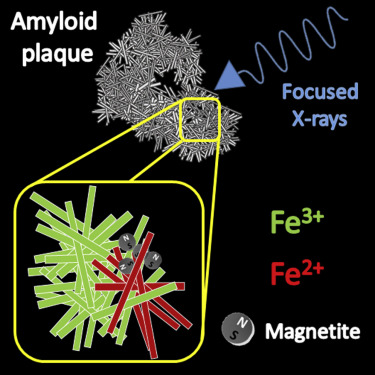当前位置:
X-MOL 学术
›
Cell Chem. Bio.
›
论文详情
Our official English website, www.x-mol.net, welcomes your
feedback! (Note: you will need to create a separate account there.)
Iron Biochemistry is Correlated with Amyloid Plaque Morphology in an Established Mouse Model of Alzheimer's Disease
Cell Chemical Biology ( IF 6.6 ) Pub Date : 2017-09-07 00:00:00 , DOI: 10.1016/j.chembiol.2017.07.014 Neil D. Telling , James Everett , Joanna F. Collingwood , Jon Dobson , Gerrit van der Laan , Joseph J. Gallagher , Jian Wang , Adam P. Hitchcock
Cell Chemical Biology ( IF 6.6 ) Pub Date : 2017-09-07 00:00:00 , DOI: 10.1016/j.chembiol.2017.07.014 Neil D. Telling , James Everett , Joanna F. Collingwood , Jon Dobson , Gerrit van der Laan , Joseph J. Gallagher , Jian Wang , Adam P. Hitchcock

|
A signature characteristic of Alzheimer's disease (AD) is aggregation of amyloid-beta (Aβ) fibrils in the brain. Nevertheless, the links between Aβ and AD pathology remain incompletely understood. It has been proposed that neurotoxicity arising from aggregation of the Aβ1-42peptide can in part be explained by metal ion binding interactions. Using advanced X-ray microscopy techniques at sub-micron resolution, we investigated relationships between iron biochemistry and AD pathology in intact cortex from an established mouse model over-producing Aβ. We found a direct correlation of amyloid plaque morphology with iron, and evidence for the formation of an iron-amyloid complex. We also show that iron biomineral deposits in the cortical tissue contain the mineral magnetite, and provide evidence that Aβ-induced chemical reduction of iron could occurin vivo. Our observations point to the specific role of iron in amyloid deposition and AD pathology, and may impact development of iron-modifying therapeutics for AD.
中文翻译:

在已建立的阿尔茨海默氏病小鼠模型中,铁生物化学与淀粉样斑块形态相关
阿尔茨海默氏病(AD)的标志性特征是大脑中淀粉样β(Aβ)纤维的聚集。然而,Aβ和AD病理之间的联系仍然不完全了解。已经提出,由Aβ1-42肽的聚集引起的神经毒性可以部分地通过金属离子结合相互作用来解释。使用亚微米分辨率的先进X射线显微镜技术,我们从建立的过量产生Aβ的小鼠模型中研究了完整皮层中铁生物化学与AD病理之间的关系。我们发现淀粉样蛋白斑块形态与铁有直接关系,并为形成铁-淀粉样蛋白复合物提供了证据。我们还表明,皮质组织中的生物铁矿物质沉积物含有矿物磁铁矿,并提供证据证明Aβ诱导的铁化学还原可能在体内发生。我们的观察结果表明铁在淀粉样蛋白沉积和AD病理学中的特定作用,并可能影响AD的铁修饰疗法的发展。
更新日期:2017-09-07
中文翻译:

在已建立的阿尔茨海默氏病小鼠模型中,铁生物化学与淀粉样斑块形态相关
阿尔茨海默氏病(AD)的标志性特征是大脑中淀粉样β(Aβ)纤维的聚集。然而,Aβ和AD病理之间的联系仍然不完全了解。已经提出,由Aβ1-42肽的聚集引起的神经毒性可以部分地通过金属离子结合相互作用来解释。使用亚微米分辨率的先进X射线显微镜技术,我们从建立的过量产生Aβ的小鼠模型中研究了完整皮层中铁生物化学与AD病理之间的关系。我们发现淀粉样蛋白斑块形态与铁有直接关系,并为形成铁-淀粉样蛋白复合物提供了证据。我们还表明,皮质组织中的生物铁矿物质沉积物含有矿物磁铁矿,并提供证据证明Aβ诱导的铁化学还原可能在体内发生。我们的观察结果表明铁在淀粉样蛋白沉积和AD病理学中的特定作用,并可能影响AD的铁修饰疗法的发展。









































 京公网安备 11010802027423号
京公网安备 11010802027423号